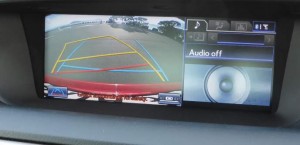Rule 202 in the Highway Code covers reversing. While it has good general knowledge, it doesn’t account for changes in technology, and some scenarios which could make it difficult for you to see an obstruction. It says:
Look carefully before you start reversing. You should
- use all your mirrors
- check the ‘blind spot’ behind you (the part of the road you cannot see easily in the mirrors)
- check there are no pedestrians (particularly children), cyclists, other road users or obstructions in the road behind you.
Reverse slowly while
- checking all around
- looking mainly through the rear window
- being aware that the front of your vehicle will swing out as you turn.
Get someone to guide you if you cannot see clearly.
There are some other things to consider with reversing that are not covered in the Highway Code.
Reversing cameras
 If your vehicle is fitted with a reversing camera you will get a view that’s perhaps 160-degrees behind the car. Distance can be difficult to judge in these images because of the fish-eye lens used, therefore many manufacturers now superimpose distance lines on the graphic, as shown.
If your vehicle is fitted with a reversing camera you will get a view that’s perhaps 160-degrees behind the car. Distance can be difficult to judge in these images because of the fish-eye lens used, therefore many manufacturers now superimpose distance lines on the graphic, as shown.
On some vehicles the lines will bend as you turn the steering wheel, giving you an indication of where the path of the vehicle is.
We wrote a much longer article about reversing cameras here.
Automatic wing mirrors
Some wing mirrors will point downwards automatically when you engage reverse. This can be useful, but also dangerous. For the left-hand mirror, it’s useful if you are parallel parking so that you don’t hit the kerb and damage your wheels. For the right-hand mirror, it’s not really useful at all, unless you are parallel parking on a one-way street on the right-hand side.
If the mirror angles itself downwards this restricts your view of the road because now all you’ll be able to see is the tarmac by your wheels. You should always look over your shoulder before you do any kind of manoeuvre, but also be aware that if you have parked and you are about to open your door that a cyclist could be obstructed from view even over your shoulder, so be very careful. Similarly, on the left-hand side of your car, watch out for obstacles that might not be visible in your mirrors.
Reversing sensors
Reversing sensors will beep or show a visual representation of the obstacle on a screen in the vehicle. They are not so good at picking up thin poles, so don’t rely on them completely. Always look over your shoulders and use your mirrors, too. If you need to, get out and walk around the vehicle to check it’s clear, or get someone to help.
Restricted rearwards visibility
Modern vehicle design has reduced the relative size of the rear window and increased the thickness of the C pillar (the pillars at the back of the car). This is to improve structural rigidity in the event of a crash, and also modern aesthetics have taken us in this direction. This means it’s often difficult to reverse accurately while just looking out of the rear window and you may need to practice reversing using your mirrors if your vehicle has a restricted rearward vision.
Automated parking systems
Some cars have parking assist features that will scan a line of parked vehicles and will look for a gap large enough to parallel park into. In these circumstances, follow the guidelines of the vehicle manufacturer. You must also take the same precautions you would normally take if you were reversing and not the car doing it automatically – check it’s safe to proceed by looking in your mirrors and over your shoulder.
